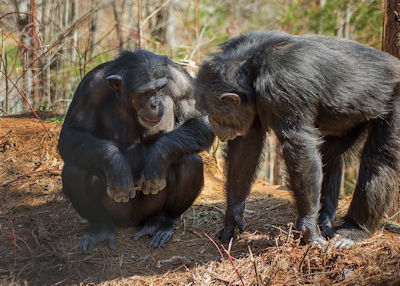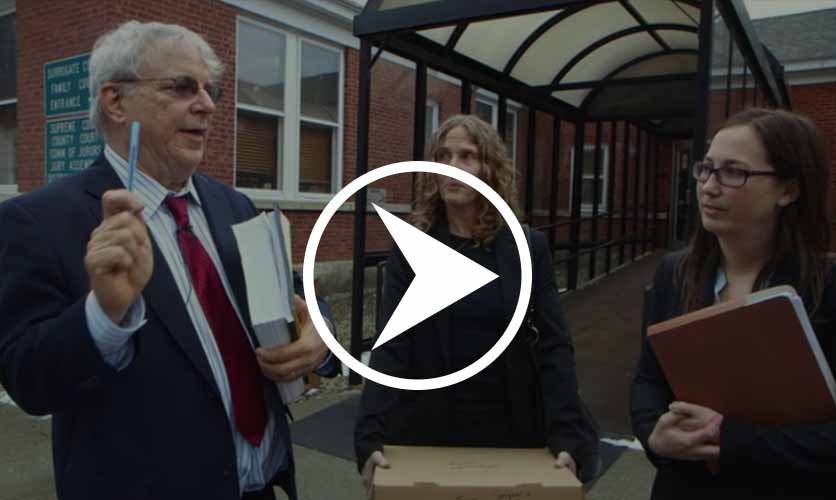Animal Rights on Trial
Animal Rights on Trial (2013-2020)

Cover of New York Times Magazine (April 27, 2014)
In December 2013, a legal document was filed in a county courthouse in the Adirondack town of Johnstown, New York that was unlike any that had ever before been filed in any courthouse in the world. The document was a petition filed by the Nonhuman Rights Project on behalf of Tommy, a chimpanzee living out his old age ten miles away in what the document described as “a small, dank, cement cage in a cavernous dark shed.” The petition asked the court to issue a writ of habeas corpus for Tommy, who the Nonhuman Rights Project asserted was a “person” under New York law, and grant him “immediate release” from his “illegal detention.”
Seven weeks earlier, the Director of the Nonhuman Rights Project, Steven Wise, had seen Tommy in his cage on a lot cluttered with transport trailers, cars, snowmobiles and boats near Gloversville, New York. He knew he’d found the right place when he saw reindeer antlers. The owner of Circle L Trailer, and of Tommy, also had a side business called Santa’s Hitching Post, a reindeer rental business for Christmas events and television ads.
Wise found Tommy crouched in his steel mesh cage watching a nature show on a portable television. He had no chimp companions, a sad situation for a member of a very social species.

Tommy in his cage (photo: NhRP)
Tommy was born in the early 1980s. He was raised from infancy by Dave Sabo, who used to own a business called “Sabo’s Chimps.” Sabo once signed Tommy on for a role as an ape called “Goliath” in the 1987 film, Project X. Bob Barker, the former TV game show host and animal rights activist, claimed that the trainers in the film used clubs to train him.
Tommy became the property of Patrick Lavery in 2008, after Dave Sabo died. Lavery said Tommy was well-cared for. “He likes being by himself,” he would tell a reporter, pointing out that Tommy had a color television to watch. Wise saw things differently. To him, Tommy was “one sad-looking chimpanzee.” He noted living alone year after year could not be an easy thing.
Background
Wise and the Nonhuman Rights Project had decided to focus on winning legal personhood for apes, cetaceans, and elephants. Wise noted that all of these animals are cognitively complex, have their own cultures, are autonomous and self-determining, and have both a theory of mind and a sense of time. It helped, he said, that apes, cetaceans, and elephants also have been researched a lot. There were scientists who can produce detailed affidavits supporting these animals’ impressive cognitive abilities.
These species, from a legal strategy standpoint, had two other things going for them. First, apes, cetaceans, and elephants are not native to North America. And second, they have no large economic value. Granting apes and elephants or dolphins their liberty would not come at a heavy cost to Americans. There are no big American industries lining up to fight against extending them freedom. Imagine, for example, trying to secure freedom for cattle. Think of all those livestock owners, dairy farmers, and food producers you’d have to fight. Freedom for dogs and cats? Well, that poses another set of challenges—think of breeders, pet stores, police dogs…not to mention pet owners.

Steven Wise in his Coral Springs, Florida office
The Nonhuman Rights Project took its fight for animal liberation into the courts knowing that judges were, by and large, a conservative bunch. As Wise put it, “They never want to get too far ahead of society.” The Project decided that a good specie to start with would be chimpanzees, who share over 98% of their DNA with humans. And, after a review of habeas corpus law in various states, the Project settled on starting their legal fight, one that Wise acknowledged could take decades, in New York State, where judges might be more open to their common law argument than in many other states. Dozens of chimps were being kept as pets or for entertainment in the United States, and several of those were in New York—including Tommy.
Tommy became the first chimpanzee to have a suit filed on his behalf. The first animal of any kind, actually. The case of The Nonhuman Rights Project on Behalf of Tommy v. Patrick Lavery, filed in Fulton County Court, asked the court to grant a writ of habeas corpus that would have the effect of freeing Tommy from his cement cage. Unlike what would be the usual case for a human being in a habeas action, the Nonhuman Rights Project was not asking simply that the court order Tommy freed. Opening the door of Tommy’s cage to let him wander where he might was no one’s idea of a good plan. Nor did the Rights Project seek to return Tommy to Africa. Captive chimps released into the wild die.
No, Steven Wise had a destination in mind for the chimp: South Florida. Where we all would like to go after we retire, right? Florida was chosen because it was home to perhaps the best sanctuary for chimpanzees in the United States. About two dozen chimpanzees live together on each of thirteen three-to-five-acre islands situated in a large artificial lake in the warm sun. A place with playgrounds, trees, water, and plenty of acreage to romp around or laze about. A place where these autonomous beings could choose who they wanted to be with and what they wanted to do.

Chimps in a sanctuary
It was called Save the Chimps sanctuary, located in Fort Pierce. When Wise first toured the sanctuary, he said he could imagine the chimps he’d help free “running around here.” The Sanctuary’s first chimps included the surviving heroes of the NASA space program and others who had been the subjects of years of painful experimentation.
Although the petition filed on behalf of the chimp Tommy was unique in legal history, there had, of course, been many suits brought to protect animals from abusive owners and inhumane treatment, suits that could be called “animal welfare cases.” Animal welfare suits allege that some human owner or institution failed to meet its statutory duty to treat animals well. Animal welfare laws on the books are numerous and diverse. They include, for example, bans on cockfighting, restrictions on puppy mills, prohibitions on the use of exotic animals in circuses, and requirements that ranchers to give chickens enough room in their cages to at least lie down. But this was different. Steven Wise called it “a civil rights case”—not an animal welfare case.
New York law states a petition for habeas corpus can be filed by any “person illegally imprisoned or otherwise restrained in his liberty.” Habeas corpus means, literally, “You shall have free the body.” Any “person” may seek the writ. And that would be the key legal question. Was “Tommy” a “person” within the meaning of the law? The position of Steven Wise and the Nonhuman Rights Project was that Tommy was not property, was not “a thing,” but as he is an autonomous being he should have rights of his own, be “a person.”
Personhood
The due process clause of the 14th Amendment says, “No state shall … deprive any person of life, liberty, or property without due process of law.” Any person. The Fifth Amendment imposes the same restriction on the federal government. Persons are entitled to life and liberty.
But what it means to be a “person” is more complicated than one might suppose. In the Citizens United case, for example, the Supreme Court found corporations to be “persons” with First Amendment protections. In fact, the Court has found that numerous things, things without hearts or brains or breath, might be “persons” with rights under the Constitution. Churches, ships, labor unions—the list is long. Personhood is a legal concept, not a biological one.
As for applying this legal concept, the courts have had to grapple with some very contentious moral issues. In the Nancy Cruzan case, the Court held that even someone in a persistent vegetative state, someone without any awareness of her environment, is still a “person” whose wishes about ending—or not ending—life must be respected.
In the case of Roe v. Wade, by contrast, the Court held that a fetus, even a fetus at eight months, is not a “person” whose life or liberty is protected under the Constitution. One becomes a “person,” the Court said, at birth. And that is true regardless of the mental abilities that a newborn baby might have. Even a baby with the most severe mental limitations, with only the most basic brain functions, is still a “person” whose right to life and liberty is deserving of full respect.
Personhood. An interesting and important constitutional question. We speak of liberty and justice for all. But what’s covered by that word “all”?
So a question. Might at least some non-human species be “persons” for some legal purposes? Beings entitled to have their freedom and autonomy respected? To not be locked in cages, to not be the subjects for painful experiments, to not be paraded in front of circus-goers or spectators at a marine park?
Federal judges generally interpret laws in accordance with the intentions reflected in the laws as they were first written, an interpretive approach not likely to lead to a happy outcome for those championing a novel cause such as animal rights. State courts, on the other hand, generally apply common law in resolving habeas corpus cases. In a state habeas corpus proceeding, a judge is more likely to be receptive to considering new evidence that might inform an evolving understanding of liberty, justice—or personhood.
Animal Rights Go to Court
Pursuing habeas corpus claims in state courts became the strategy adopted by Steven Wise, president and founder of the Nonhuman Rights Project. After graduating from law school, he worked as a personal injury lawyer. But he was inspired to take his legal career in a different direction after reading Peter Singer's 1975 book Animal Liberation.

Peter Singer's book, Animal Liberation
The Nonhuman Rights Project was not the first organization to try to use the courts to liberate animals, just the first to use the strategy of filing habeas corpus petitions to do it. An earlier, unsuccessful attempt to free orcas from being held captive for entertainment purposes by SeaWorld was filed in 2011 by the People for the Ethical Treatment of Animals. The PETA suit alleged that SeaWorld’s actions constituted a violation of the Thirteenth Amendment’s prohibition of slavery—arguing, in effect, the orcas were slaves and SeaWorld their master. A federal Judge of the District Court for southern California was not impressed. Judge Jeffrey Mller wrote, “the only reasonable interpretation of the 13th Amendment’s plain language is that it applies to persons, and not to nonpersons such as orcas.” Wise was not happy with PETA’s suit, viewing it as a certain loser that established bad law. “That’s precisely why we’re avoiding the federal courts,” he said.

Orcas performing at SeaWorld
The Nonhuman Rights Projects suit depended on convincing state judges that chimpanzees were persons, at least for purposes of their habeas corpus actions. Wise compared chimps to pre-school-age children. Chimps and young children both exhibit a range of emotions, can understand other minds, and have problem solving abilities. Given a chance, they can master an impressive vocabulary in sign language. Researchers have even seen chimps teaching other chimps sign language—and then watched as those chimps use sign language to communicate among themselves.
And just as three-year olds held in unlawful custody would not be in a position to sue for themselves, chimps need humans to bring an action to enforce their legal rights. At least that was the position of the Nonhuman Rights Project.
The legal filing on behalf of Tommy included affidavits from scientific experts around the world, from Japan to Sweden to the United States. They were unanimous in their belief that chimpanzees shared with humans all the essential abilities and feelings, including autonomy, to make them deserving of rights of their own.
In the day or two before arguments in Tommy’s case, Steven Wise made rounds on national television. He explained in an interview on Good Morning America that a habeas corpus action is appropriate when a person is unjustly held. If Tommy were a human held in a concrete cage without his consent, the case would be a no-brainer. The challenge was getting judges to extend the definition of “persons” to include chimpanzees. . . Continued

